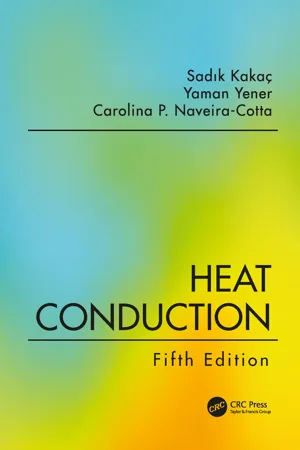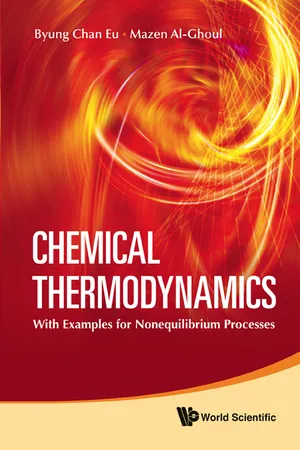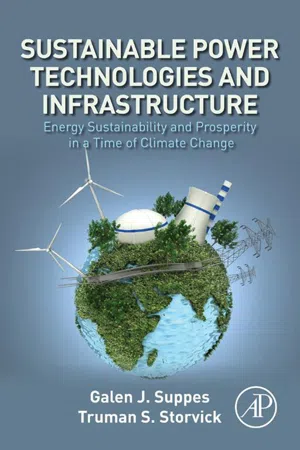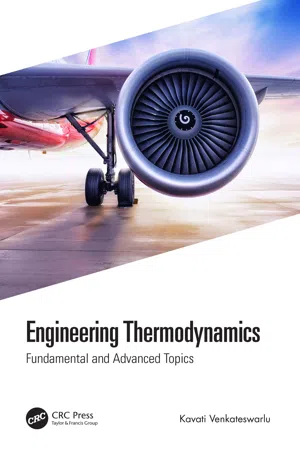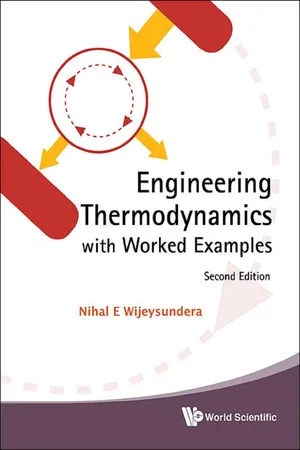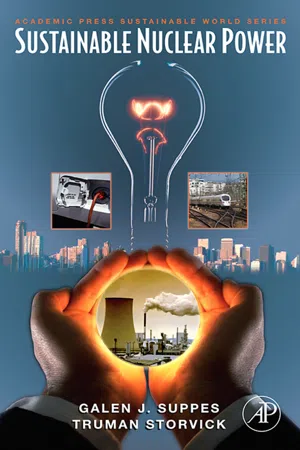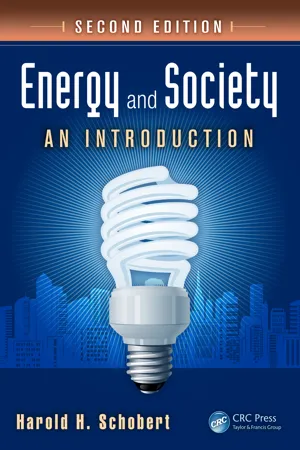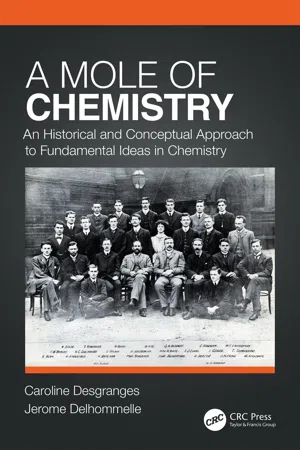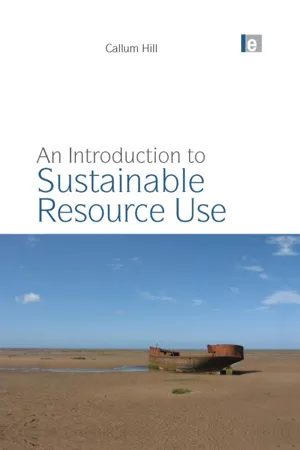Technology & Engineering
Heat and Work
Heat and work are forms of energy transfer in thermodynamics. Heat is the transfer of energy due to a temperature difference, while work is the transfer of energy due to a force acting over a distance. Both heat and work are important in understanding the behavior of systems and processes in engineering and technology.
Written by Perlego with AI-assistance
Related key terms
12 Key excerpts on "Heat and Work"
- eBook - ePub
Physics of Cryogenics
An Ultralow Temperature Phenomenon
- Bahman Zohuri(Author)
- 2017(Publication Date)
- Elsevier(Publisher)
These may be called energy transfer or energy interactions and they bring about changes in the properties of the system. Positive work occurs when the system transfers energy to its surroundings by some mechanical or electrical process. Positive heat transfer occurs when the surroundings transfer thermal energy to the system. Normally a temperature difference is the driving potential that moves thermal energy into or out of a system.4.2. Definition of Work
The formal definition of work is “a force acting through a distance.” When a system undergoes a displacement due to the action of a force, work is taking place and the amount of work is equal to the product of the force and the displacement in the direction of the force. The term work is so common with many meanings in the English language that it is important to be very specific in its thermodynamic definition.4.2.1. Work Is Done by a Force as It Acts Upon a Body Moving in the Direction of the Force
If the force acts, but no movement takes place, no work is done. Work is performed by the expanding exhaust gases after combustion occurs in a cylinder of an automobile engine as shown in Fig. 4.1 . In this case the energy produced by the combustion process can be transferred to the crankshaft by means of the connecting rod, in the form of work. Therefore, the work can be thought of as energy being transferred across the boundary of a system, the system being the gases in the cylinder.A similar concept is the work done in the turbine to generate electricity in a nuclear power plant. The gas pressure rotates the turbine blades producing a torque that turns a generator. Thermal energy is transferred from the reactor core to the steam generator in the first loop. The second loop then uses this steam to drive the turbine. See Fig. 4.2 - eBook - ePub
- Sadık Kakac, Yaman Yener, Carolina P. Naveira-Cotta(Authors)
- 2018(Publication Date)
- CRC Press(Publisher)
1 Foundations of Heat Transfer 1.1 Introductory Remarks Heat transfer is that branch of engineering science which studies the transfer of energy solely as a result of temperature differences. Heat transfer problems confront engineers and researchers in nearly every branch of engineering and science. Although it is generally regarded as most closely related to mechanical engineering, much work in this field has also been done in chemical, nuclear, metallurgical, and electrical engineering, where heat transfer problems are equally important. It is probably this fundamental and widespread influence that has helped the field of heat transfer develop as an engineering science. Thermodynamics, another branch of the engineering science, studies Heat and Work interactions of a system with its surroundings, and defines heat as the form of energy that crosses the boundary of a system by virtue of a temperature difference existing between the system and its surroundings. That is, heat is the energy in transition across the system boundary and temperature difference is the driving potential for its propagation. Since heat is energy in transit, one should really talk about the transfer or flow of heat. Heat flow is vectorial in the sense that it is in the direction of a negative temperature gradient, that is, from higher toward lower temperatures. The laws of thermodynamics may be used to predict the gross amount of heat transferred to or from a system during a process in which the system goes from one thermodynamic state (i.e., mechanical and chemical, as well as thermal equilibrium) to another. In most instances, however, the overriding consideration may be the time period over which the transfer of heat occurs or, simply, the time rate at which it takes place. The laws of thermodynamics alone are not sufficient to provide such information; neither can they explain the mechanisms of heat transfer, which are not strictly restricted to equilibrium states - eBook - ePub
Chemical Thermodynamics
With Examples for Nonequilibrium Processes
- Byung Chan Eu, Mazen Al-Ghoul(Authors)
- 2010(Publication Date)
- WSPC(Publisher)
Chapter 2 Temperature, Work, and HeatTemperature, work, and heat are three basic concepts underlying the science of thermodynamics, the scientific quantification of which traces back to the very beginning of thermodynamics. Feeling hot or cold is a physiological sensation that we have when we touch an object, but such sensation was not given an objective measure until the times of Galileo. Furthermore, the relation of temperature to heat and the relation of work to heat have evolved through the history of science, their evolution embodying our struggle to understand their nature. In this chapter, we discuss their quantification, so that they can be made use of in the subsequent study of thermodynamics in a scientific and logical manner.2.1 TemperatureTemperature is not only one of the most important quantities in thermodynamics but also one of the basic state variables, in terms of which thermal properties of matter can be characterized and reckoned with. Its quantification had taken a long winding process of evolution in thoughts before the concept took the form currently in universal use. It is introduced as a quantifiable quantity by the zeroth law of thermodynamics stated below.If two bodies of different degrees of hotness are put into contact, the difference in hotness eventually disappears between the two bodies, and we say that they are in thermal equilibrium. What in fact happens when such two bodies are put into thermal contact is that heat flows from the hotter body to the colder one until there is no difference in hotness or coldness. Such a phenomenon is experienced in our everyday life. In order to develop the science of thermodynamics it is necessary to quantify the sense of hotness and coldness. The desired quantification is essentially achieved by the following law:Fig. 2.1 Thermal equilibrium and the definition of temperature. Pairs of systems A, B, and C - eBook - ePub
- Irving Granet, Jorge Alvarado, Maurice Bluestein(Authors)
- 2020(Publication Date)
- CRC Press(Publisher)
We shall use the convention that heat to a system from its surroundings is positive and that heat out of a system is negative . To learn these conventions, it is convenient to consider the typical situation in which heat is transferred to a system to obtain useful work from the system. This sets the convention that heat into a system is positive and work out of the system is also positive. Positive in this sense means either desirable or conventional from the viewpoint of conventional power cycles. For refrigeration cycles, the opposite of this convention will be more useful.It is important to recognize the difference between heat and temperature. Temperature is a measure of the energy contained in the molecules of a system due to their motion. When the temperature of a system is greater than that of its surroundings, some of that molecular energy is transferred to the surroundings in what we call heat. Thus, temperature is a property of a system in a given state, whereas heat is associated with a change in the state of a system.Because work and heat are both forms of energy in transition, it follows that the units of work should be capable of being expressed as heat units, and vice versa. In the English system of units the conversion factor between work and heat, sometimes called mechanical equivalent of heat , is 778.169ft.·lbf /Btu and is conventionally given the symbol J . We shall use this symbol to designate 778ft.·lbf /Btu, because this is sufficiently accurate for engineering applications of thermodynamics. In the SI system, this conversion factor is not necessary, because the joule (N·m) is the basic energy unit.There are two forms of heat transfer: sensible heat and latent heat. Sensible heat transfer occurs when there is a temperature difference between bodies or systems and the amount of heat transferred is related to the magnitude of that difference. This is the most common form. Latent heat transfer occurs when a body is changing state, such as evaporating from liquid to gas or condensing from gas to liquid. The change of phase occurs at constant temperature. This form of heat transfer is utilized in refrigeration and air conditioning systems (see Chapters 7 and 10 - eBook - ePub
Sustainable Power Technologies and Infrastructure
Energy Sustainability and Prosperity in a Time of Climate Change
- Galen J. Suppes, Truman S. Storvick(Authors)
- 2015(Publication Date)
- Academic Press(Publisher)
Classical thermodynamics is an exact mathematical structure that describes the behavior of gases, liquids, and solids as their temperature, pressure, and composition change. The simple form of these mathematical relationships was established using experiments performed to improve the design of engines that convert thermal energy to work. The theory applies equally to energy conversions involved in heating and cooling a house, conversion of energy from coal combustion to electricity, combustion of gasoline to power an automobile, and the conversion of food to energy used to walk and talk.Our narrative will proceed with some examples of tasks we understand as work. These examples will give us a quantitative definition of work and we can then assign numerical units to energy. We will show how any gas can be used to do work. We then show how we can use water as a liquid or a vapor (steam) as the fluid to accept thermal energy, do work, and then reject the remaining thermal energy to complete the work-producing cycle. Today’s machines that convert energy to work use this basic principle.The Concept of Work
Everyone understands that work is the use of energy to perform a task. It is work to lift a box from the floor to a table. Shoveling sand or snow is work. When we carry a bag of groceries from the store to the parking lot, it is work. All tasks we do that have us moving an object from one place to another we understand to be work. When we repeat the task several times, we need rest, and we need food to restore the energy we used for performing those tasks. This qualitative description forms the basis for the scientific definition of work.The scientific definition of work used in physics must be mathematically exact. This is necessary because the numerical value of the work we assign to a task must be the same for every scientist or technologist who does the analysis. This allows scientists to communicate efficiently. The definition we use in physics follows: work is the numerical value of a force multiplied by the distance over which that force is applied . We can use this definition to compute the work required to lift a box from the floor to a table.Earth exerts a force on all objects near it. This force is gravity. We measure this force in pounds. When a 10-pound box is lifted 2 feet from the floor to the top of a table, 20 foot-pound work is done against the force of gravity. - eBook - ePub
Engineering Thermodynamics
Fundamental and Advanced Topics
- Kavati Venkateswarlu(Author)
- 2020(Publication Date)
- CRC Press(Publisher)
surr . For a gray surface (α = ε), the net rate of radiation heat transfer is the difference between these two surfaces given byand per unit area of the surface, the net radiation heat transfer is given by(3.19)= ε σ AQ ˙rad(T s 4−T surr 4)Eq. 3.19 gives the difference between thermal energy released due to radiation emission and that gained due to radiation absorption.= ε σQ ˙rad(T s 4−T surr 4)3.5 Work Transfer
The concept of work in thermodynamics is a normal extension of the concept of work in mechanics. In mechanics, work can be defined as a force F acting through a displacement s, soδ W = F d sWe can evaluate the work if the force F as a function of displacement s is known.(3.20)W=1 - 2∫ 1 2F d sIn thermodynamics, work can be defined as follows: “work is said to be done by a system on its surroundings, if the sole effect on the things external to the system is the raising of a weight”. Thus the raising of a weight, in effect, is a force acting through a distance.Work is also an energy interaction between a system and its surroundings. Energy can cross the boundary of a closed system in the form of heat or work. If the energy interaction between a system and its surroundings is not by heat, it must be by work. The driving force for heat transfer is the temperature difference between the system and its surroundings. Then an energy interaction that is not caused by a temperature difference between a system and its surroundings is work. More clearly, work is the energy transfer associated with a force acting through a distance. A rotating rotor as in a turbo-generator system, electrical work from a battery, and chemical work are some of the examples of work transfer. Work, like heat, has energy units kJ. The work done during a process between states 1 and 2 is denoted by W1-2 , or simply W.(3.21)∫ 1 2δ W =W 1-2The value of this integral should not be indicated as W2 − W1 - eBook - ePub
- Nihal E Wijeysundera(Author)
- 2016(Publication Date)
- WSPC(Publisher)
If left for sometime this heat interaction will cease when the temperatures of the wall and the gas have become equal and thermal equilibrium is established. From a microscopic view point, the energy from the vibrating atoms at the surface of the wall transfer energy to molecules of gas due to random collisions with the latter. This is a disorganized form of energy transfer and is therefore not observed as work from a macroscopic view. As in the case of work, a system or body does not possess heat and therefore heat is not a property. The evaluation of the magnitude of the heat interaction during a process requires knowledge of the path of the process.Fig. 3.8 Heat interaction between wall and gasA system boundary that prevents heat interactions across it is called an adiabatic boundary or wall . Very low thermal conductivity insulation materials and the hollow evacuated space in a vacuum flask are approximations to adiabatic walls.3.9Comparison of Heat and Work
From our discussions thus far we notice that there are many similarities between Heat and Work interactions. These are summarized below. (i)Heat and Work are both energy in transit. (ii)Systems or bodies do not possess heat or work. (iii)Heat and Work are not properties of a system. (iv)The evaluation of the magnitude of the Heat and Work interactions between a system and its surroundings during a process requires knowledge of the process path.Despite these similarities, there are some important differences between Heat and Work that will become evident when we introduce the second law of thermodynamics in chapter 6 .3.10 Worked Examples
Example 3.1 A sealed hollow cylinder of cross sectional area A and heightFig. E3.1 Forces on an immersed cylinderHois pushed to the bottom of a large tank of water as shown in Fig. E3.1 . Assuming that the height H of the water does not change due to its large volume, obtain an expression for the total work done on the cylinder by the external force when the process is carried out in a quasi-static manner. The ambient pressure isPo.Solution Consider the vertical force balance on the cylinder when its lower surface is at a height z (z <Ho - Alexander V. Dimitrov(Author)
- 2017(Publication Date)
- CRC Press(Publisher)
2Conversion of Thermal Energy into Mechanical Work (Thermal Engines)Energy-related (power) technologies may be treated as a combination of engineering-technical methods of energy and work conversion employed to facilitate human life. They are divided into two main groups. The first group comprises technologies of heat conversion into another type of energy (mechanical, electrical, electromagnetic, etc.) while the second one comprises technologies of heat transfer, accumulation, and regeneration. Each thermal technology discussed herein will be illustrated by specific physical schemes and devices. We shall consider them in the following order:•Technologies of mechanical work performance (so called thermomechanical technologies) •Technologies of generation of electrical energy (thermoelectric technologies) •Technologies of heat transformation (regeneration and recuperation) •Technologies of heat transfer and collection (transfer and accumulation) •Technologies creating comfortable environment (air conditioning and ventilation)Thus, we will treat a certain technology as an object of study of respective scientific-applied research fields, on one hand, and we will follow the teaching programs on “Power engineering,” “Transport management” and “General mechanical engineering,” on the other hand.2.1 Evolution of Engine TechnologiesAs is known from physics, energy conversion follows a natural course, that is, energy of motion of macro- and microbodies (popular as mechanical energy) is converted into heat by mechanisms that are studied by tribology (including dry, semi-dry, viscous, or turbulent friction). No opposite transformation is observed in nature. Heat conversion into energy needed for the operation of machines and mechanisms was an impossible task for primitive people as well as for those living in slave-holding* and feudal†- eBook - ePub
- Galen J. Suppes, Truman Storvick(Authors)
- 2006(Publication Date)
- Academic Press(Publisher)
CHAPTER 5History of Conversion of Thermal Energy to Work
Publisher Summary
Classical thermodynamics is a mathematical structure that describes the behavior of gases, liquids, and solids as the temperature, pressure, and composition change. Work is the numerical value of a force multiplied by the distance over which that force is applied. The energy is released when the molecules that make up the fuel break apart and chemically combine with oxygen in the air to form new molecules. This oxidation reaction destroys the fuel chemicals to produce carbon dioxide and water vapor, releasing heat in the process. The thermal energy that is released is diffused and it moves in all directions with equal ease. The development of heat engines to convert this diffused thermal energy to useful work set the path of the industrial revolution. Different types of engines and their working principles are described. The steam turbine is the primary source of power to drive dynamos in electric power stations. The primary measure of performance for steam engines and turbines is thermal efficiency, which is the amount of shaft work produced divided by the amount of heat taken from the boiler. Practical fuel cells were designed during 1960s and were first used during the NASA Apollo program. The fuel cells are fueled with stored hydrogen and oxygen. Different chemical reactions produce different fuel cell voltages. Fuel cells have great potential for socio-economic benefits and can be improved with the use of grid electricity.The story of energy conversion is the story of life. It is the story of people coming out of the caves to harness the environment. It is the story of conquest. And it is the story of the rise and fall of empires. The many forms of energy surround us every day, including the energy that fuels life itself.As illustrated by Figure 5-1 - eBook - ePub
Energy and Society
An Introduction, Second Edition
- Harold H. Schobert(Author)
- 2014(Publication Date)
- CRC Press(Publisher)
Some heat must be passed to the cold side. This fundamental limitation means that achieving a high efficiency from the heat engine cannot be done by lowering the temperature of the cold side arbitrarily (because we “hit a wall” at absolute zero). Therefore, the only practical alternative is to raise the temperature of the hot side as much as possible. In doing this, the limitation is the high-temperature strength of the materials of the engine and, in some ultimate sense, the melting point of the material used to make the engine. EQUIVALENCE OF Heat and Work The idea that heat is not a fluid but, rather, is a form of motion was occasionally advanced by scientists, many of whom are among the great names of science: Francis Bacon, Robert Boyle, and Isaac Newton as examples. Heat is a very brisk agitation of the insensible parts of the object (i.e., the atoms), which produces in us that sensation from which we denominate the object hot; so that what in our sensation is heat, in the object is nothing but motion. —Locke 7 John Locke is now best known as a philosopher, but he was active as a physician and did a certain amount of work in experimental chemistry. The person credited with establishing a link between heat and motion was Benjamin Thompson (Count Rumford, Figure 11.9), certainly one of the most colorful characters in the history of science. * In the late eighteenth century, it was observed that drilling the “bore” into cannon barrels makes them very hot. The process generates so much heat that, if the barrel and the drill were covered with water, the water would get hot enough to boil. As the boring was continued, there were two further observations: The water still got hot even when the drill was so dull that it was no longer cutting metal - eBook - ePub
A Mole of Chemistry
An Historical and Conceptual Approach to Fundamental Ideas in Chemistry
- Caroline Desgranges, Jerome Delhommelle(Authors)
- 2020(Publication Date)
- CRC Press(Publisher)
Let us add that Clapeyron is also known for an equation bearing his name, later called the Clausius–Clapeyron relation. This time, Clapeyron concentrates his efforts on the PT plane. He succeeds in determining “phase diagrams”, which delimit regions in the PT plane where the different states of matter (liquid, solid, vapor) exist. Thanks to this representation, it is thus possible to know if, for example, ice is converted into water for a given temperature and pressure. We can then easily define the changes in states, such as vaporization (transition from a liquid state to a vapor state), condensation (vapor to liquid), solidification (liquid to solid), fusion (solid to liquid) and sublimation (solid to gas). The Clausius–Clapeyron relation gives the slope of the tangents of this curve: dP/dT = L/(TdV), where dP/dT is the slope of the tangent to the coexistence curve at any point, L the latent heat and dV is the specific volume change of the phase transition. Nowadays, latent heat is called enthalpy of change and is defined as the necessary quantity of energy for 1 mole or 1 kg of a pure body to change its state.Constitution and Laws of Thermodynamics
Since Newton, mechanics is the favored approach to explain phenomena occurring in Nature. Basically, if something happens, it means that there is a cause – or, in other words, if there are no external forces acting on a system, nothing should happen. However, from Carnot’s observations, it seems that heat passes from hot to cold without anything, or anyone, from the outside intervening to trigger this transfer. What happens is a mystery!An answer comes from Joule (1818–1889). In the process of making a link between the effects of mechanical action and the resulting heat, Joule carries out an interesting experiment. The apparatus consists of two weights and of a paddlewheel immersed in a barrel of water. Because of gravity, the weights become falling weights that spin the paddle wheel (see Figure 2.14 - eBook - ePub
- Callum Hill(Author)
- 2012(Publication Date)
- Routledge(Publisher)
Nonetheless, the caloric theory of heat was still current when James Prescott Joule reported on a very precise determination of the mechanical equivalence of heat in 1845. As well as being a physicist, Joule was also a brewer, and his experience allowed him to design extremely precise pieces of equipment for measuring slight temperature changes in the water. His most famous apparatus consisted of weights connected to paddle wheels which sat in a container full of water. The amount of mechanical energy transferred to the water could be calculated by knowing the measurements of each weight and how far it had dropped. The results from this and other similar experiments were initially met with scepticism, since they showed that the caloric theory of heat could not possibly be correct. The experiment demonstrat- ed that mechanical work could be turned into heat, but the increase in temperature of the water tank could have been produced just as easily by using a flame to heat up the water. The result would be indistinguishable. For this reason mechanical work and heat must be equivalent and both have to be considered to be forms of energy. Caloric (heat) was not conserved, but energy was. But what was energy?In order to understand the concept of energy better, we have to go back a little in time and the first theoretical study of the efficiency of a steam engine.Efficiency
In 1824, twenty years before Joule performed his famous experiment, a 28-year- old French scientist called Nicholas Léonard Sadi Carnot published a book entitled Réflexions sur la Puissance Motrice du Feu et sur les Machines Propres à Développèr cette Puissance ( Reflections on the Motive Power of Heat and on Machines Fitted to Develop that Power ). In this book, Carnot considered the properties of an ideal heat engine. The actual details of the construction of the engine did not matter, since this was a theoretical study. In fact, Carnot proved that the design of the heat engine was irrelevant to the conclusions that he reached. A heat engine is any machine that converts thermal energy to motion; examples include steam engines, petrol engines, diesel engines and gas turbines. The basis of the operation of such a heat engine is shown in Figure 2.1.Figure 2.1 A diagram showing the principle of the Carnot heat engineA hot source is linked through the heat engine to a cold sink and mechanical work (often called shaft work) is extracted from the engine. This is a spontaneous process. Heat is flowing from hot to cold and the question is how much of this heat energy can be diverted into mechanical work before the process becomes impossible. The concept was rooted in caloric theory and Carnot was considering the flow of caloric through the machine. However, the use of caloric theory does not invalidate the conclusions that Carnot reached in this study.
Index pages curate the most relevant extracts from our library of academic textbooks. They’ve been created using an in-house natural language model (NLM), each adding context and meaning to key research topics.

